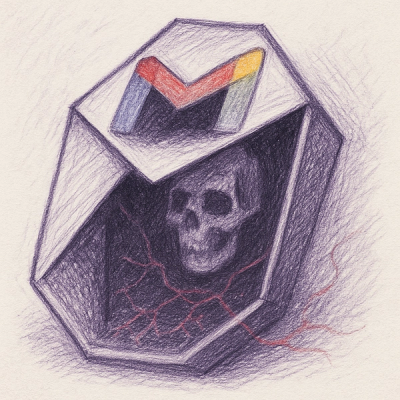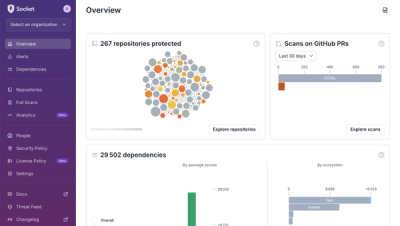
Research
wget to Wipeout: Malicious Go Modules Fetch Destructive Payload
Socket's research uncovers three dangerous Go modules that contain obfuscated disk-wiping malware, threatening complete data loss.
Ruby-Binary-Parser is Ruby Gem library providing DSL for parsing binary-data, such as Image files, Video files, etc. Without operating bytes and bits complicatedly, you can parse and read binary-data generically and abstractly.
This library can parse all kind of binary-data structures including non-fixed length of structures and nested structures. For generic parsing, loop and condition(if) statement to define structures is provided in this library. Of course, values of neighbor binary-data can be used as the other binary-data's specification of length.
Furthermore, this library handles all binary-data under the lazy evaluation. So you can read required parts of a binary-data very quickly even if whole of the binary-data is too big,
Currently, this library supports only READ of binary-data. So you cannot WRITE binary-data directly with this library.
Look at following examples to quickly understand how to use this library.
$ gem install binary_parser
Consider the following (temporary) binary structures which describe Image data.
| MyImage (non-fixed length) | |||
| Data Name | Type | Bit Length | Number Of Replications |
| height | UInt | 8 | 1 |
| width | UInt | 8 | 1 |
| RGB color bit-map | UInt | 8 * 3 | 'height' * 'width' |
| has date? | Flag | 1 | 1 |
| date | MyDate | 31 | 'has date?' is 1 => 1 else => 0 |
| MyDate (31 bit) | |||
| Data Name | Type | Bit Length | Number Of Replications |
| year | UInt | 13 | 1 |
| month | UInt | 9 | 1 |
| day | UInt | 9 | 1 |
You can define MyImage structure in ruby program as following code.
require 'binary_parser'
class MyDate < BinaryParser::TemplateBase
require 'date'
Def do
data :year, UInt, 13
data :month, UInt, 9
data :day, UInt, 9
end
def to_date
return Date.new(year.to_i, month.to_i, day.to_i)
end
end
class MyImage < BinaryParser::TemplateBase
Def do
data :height, UInt, 8
data :width, UInt, 8
# Loop statement
TIMES var(:height), :i do
TIMES var(:width), :j do
data :R, UInt, 8
data :G, UInt, 8
data :B, UInt, 8
end
end
data :has_date, Flag, 1
# Condition statement
# * If you want to check whether variable-name is valid, alternative expression
# IF cond(:has_date){|v| v.on?} do ~ end
# is also available.
IF E{ has_date.on? } do
data :date, MyDate, 31
end
end
end
And then you can parse and read binay-data of MyImage as follows.
File.open('my_image.bin', 'rb') do |f|
image = MyImage.new(f.read)
puts "Image size: #{image.height}x#{image.width}"
ul = image.i[0].j[0]
puts "RGB color at the first is (#{ul.R}, #{ul.G}, #{ul.B})"
puts "Image date: #{image.date.to_date}"
end
If 'my_image.bin' is binary-data-file of [0x02, 0x02, 0xe7,0x39,0x62, 0x00,0x00,0x00, 0xe7,0x39,0x62, 0x00,0x00,0x00, 0x9f, 0x78, 0x08, 0x03], you can get output as follows.
Image size: 2x2
RGB color at the first is (231, 57, 98)
Image date: 2014-04-03
For your information, you can dump all binary-data's information as follows.
File.open('my_image.bin', 'rb') do |f|
image = MyImage.new(f.read)
image.show(true)
end
You can also define other structures as follows.
class DefExample < BinaryParser::TemplateBase
Def do
data :loop_byte_length, UInt, 8
# Loop until 'loop_byte_length' * 8 bits are parsed.
SPEND var(:loop_byte_length) * 8, :list do
data :length, UInt, 8
# You can specify length by neigbor value.
data :data, Binary, var(:length) * 8
end
data :v1, UInt, 8
data :v2, UInt, 8
# Number of Condition variables is arbitary.
IF cond(:v1, :v2){|v1, v2| v1 == v2} do
# +, -, *, / is available to specify length with variable.
data :v3, UInt, 8 * (var(:v1) + var(:v2))
end
end
end
You can check this definition by giving some binary-data and calling show method as follows.
binary = [0x05, 0x01, 0xff, 0x02, 0xff, 0xff, 0x01, 0x01, 0x01, 0x01].pack("C*")
i = DefExample.new(binary)
i.show(true)
Output for above checking-code is shown below.
*--------------------------------------------------------------------------------
loop_byte_length Pos: 0 Len: 8 Type: UInt Cont: 5
list Pos: 8 Len: 40 Type: LoopList Cont: list with 2 elements
[0]
*--------------------------------------------------------------------------------
length Pos: 0 Len: 8 Type: UInt Cont: 1
data Pos: 8 Len: 8 Type: Binary Cont: [0xff]
[1]
*--------------------------------------------------------------------------------
length Pos: 0 Len: 8 Type: UInt Cont: 2
data Pos: 8 Len: 16 Type: Binary Cont: [0xff, 0xff]
v1 Pos: 48 Len: 8 Type: UInt Cont: 1
v2 Pos: 56 Len: 8 Type: UInt Cont: 1
v3 Pos: 64 Len: 16 Type: UInt Cont: 257
If you want to operate Stream-data, StreamTemplateBase class is useful. Define stream as follows.
class StreamExample < BinaryParser::StreamTemplateBase
# Stream which consists of 4bytes-binary-datas.
Def(4) do
data :data1, UInt, 8
data :data2, Binary, 24
end
end
And then, get structures from the stream as follows.
File.open('my_image.bin', 'rb') do |f|
stream = StreamExample.new(f)
packet = stream.get_next
puts "data1: #{packet.data1}, data2: #{packet.data2}"
stream.get_next.show(true)
end
StreamTemplateBase has many useful methods to choose structures from the stream. If you want to know detail of these methods, please read documentation or concerned source-files.
I'm sorry, but only RDoc (auto-generated documentation) is now available. For example, you can read RDoc on web browser by following operations.
$ gem install binary_parser
$ gem server
Server started at http://0.0.0.0:8808
Access shown address by web browser.
1.0.0 April 6, 2014
1.2.0 November 7, 2014
FAQs
Unknown package
We found that binary_parser demonstrated a not healthy version release cadence and project activity because the last version was released a year ago. It has 1 open source maintainer collaborating on the project.
Did you know?

Socket for GitHub automatically highlights issues in each pull request and monitors the health of all your open source dependencies. Discover the contents of your packages and block harmful activity before you install or update your dependencies.

Research
Socket's research uncovers three dangerous Go modules that contain obfuscated disk-wiping malware, threatening complete data loss.

Research
Socket uncovers malicious packages on PyPI using Gmail's SMTP protocol for command and control (C2) to exfiltrate data and execute commands.

Product
We redesigned Socket's first logged-in page to display rich and insightful visualizations about your repositories protected against supply chain threats.